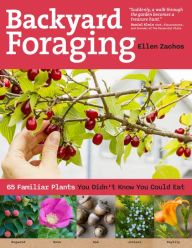Chris Bennett is a forager, writer, cheesemonger, and trained chef. He has worked with top chefs around the Southeast providing unique ingredients to the area’s best restaurants. He has been featured in Birmingham Magazine, Cooking Light, Garden & Gun, Discover St. Clair, and The Hot and Hot Fish Club Cookbook. He is a frequent speaker, and was selected as one of Southern Living magazine’s “50 Innovators Changing the South.”
Southeast Foraging: 120 Wild and Flavorful Edibles from Angelica to Wild Plums
Paperback
$24.99
- ISBN-13: 9781604694994
- Publisher: Timber Press, Incorporated
- Publication date: 04/22/2015
- Series: Regional Foraging Series
- Pages: 296
- Sales rank: 63,074
- Product dimensions: 6.50(w) x 8.90(h) x 0.80(d)
Eligible for FREE SHIPPING details
.
24.99
Out Of Stock
From seashores and riverbanks to mountains, valleys, and overgrown fields, the beautiful Southeast is rich in wild edibles. Forager, farmer, teacher, and chef Chris Bennett helps you find the most delicious plants—from delectable wild greens, like the often-overlooked sweet, fan-shaped leaves of common mallow to wild hazelnuts, hickory nuts, and fruity black walnuts. Try making syrup from summer’s honeysuckle blooms, simmer a rosehip jam, or pickle some blackberries in vinegar to spark up a savory dish. Whether you venture out on the water for cattail corndogs and wild rice or stay close to home for the candy-crunch of hackberry fruits, this book will help you find an abundance of wild plants right outside your door.
Customers Who Bought This Item Also Bought
-
- Backyard Foraging: 65 Familiar…
- by Ellen Zachos
-
- Edible and Medicinal Plants of…
- by Sarah GoodinMichael Moore
-
- The Forager's Harvest: A…
- by Samuel Thayer
-
- Birds of Tennessee Field Guide
- by Stan Tekiela
-
- Birds of Kentucky Field Guide
- by Stan Tekiela
-
- Peterson Field Guide to…
- by Steven FosterJames A. Duke
-
- Birds of Georgia Field Guide
- by Stan Tekiela
-
- Nature's Garden: A Guide…
- by Samuel Thayer
-
- Florida Freshwater Fishes
- by Eric Brazer
-
- Edible Wild Plants: Wild Foods…
- by John Kallas
-
- All That the Rain Promises and…
- by David Arora
-
- Weeds of the South
- by Alan F. WieseB. SmithBrett ServissC. MonksC. ElmoreDavid BridgesDavid JohnsonDavid JordanDavid HallDon MurrayE.J. Retzinger Jr.J. StritzkeJ. KeelingJames ChandlerJennifer GoodlettJohn CardinaJohn BoydJonathan GreenL. OliverLoyd WaxLynn. SosnoskieMary KetchersidMississippi Weed Science SocietyMitchell BlairNancy CoileNeil HackettPatricia HaraganRobert HayesRoger BeckerRonald TyrlScott FittererShawn AskewSouthern Weed Science SocietySteve ShaafSteven HarrisonTerry ClasonTheodore WebsterTimothy MurphyVictor MaddoxWalter SkrochCharles BrysonMichael DeFeliceArlyn Evans
-
- Tom Brown's Field Guide to…
- by Tom Brown
-
- Peterson Field Guide to…
- by Robert PowellRoger ConantJoseph T. Collins
-
- Common Mosses of the Northeast…
- by Karl B McKnightJoseph R. RohrerKirsten McKnight WardWarren J. Perdrizet
-
- Five Acres and Independence
- by Maurice G. Kains
Recently Viewed
From the Publisher
A fabulous field guide to sustainable, adventurous eating down South.” —Library Journal “I’ve been waiting years for this book. This is the ultimate guide, and Chris is the undisputed heavyweight champion of foraging in the South.” —Sean Brock, author of Heritage and chef of McCradys, Minero, and Husk “Chris Bennett is a thoughtful and expert southern chef who knows his wild plants. This book will open a new world to beginning foragers and will make an already rich regional food culture even richer.” —Hank Shaw, James Beard Award–winning author of Hunter Angler Gardener Cook “A wonderful reference for anyone with an interest in foraging. . . . may spark an unrealized fascination.” —Smith Mountain LakerDennis BlÃhse
“A fun guide down the woodland path to discover definitely different, safe-to-eat native plants.
Hank Shaw
"Chris Bennett is a thoughtful amd expert southern chef who knows his wild plants. This book will open a new world to beginning foragers and will make an already rich regional food culture even richer."
Sean Brock
"I've been waiting for this book. This is the ultimate guide, and Chris is the undisputed heavyweight champion of foraging in the South."
Library Journal
04/15/2015Instead of kale, how about kudzu? "The vine that ate the South" is just one of 120 flavorful wild edibles featured in this work by Alabama-based forager, cheesemonger, and chef Bennett, who has written on this subject for Garden and Gun magazine and other publications. A companion to Northeast Foraging, produced by Timber last year, this reference offers alphabetically arranged entries that outline how to identify, harvest, prepare, and enjoy a wide range of nuts, fruits, shoots, leaves, and more. An array of color photographs is also included. VERDICT A fabulous field guide to sustainable, adventurous eating down South.





















